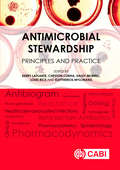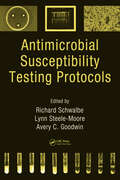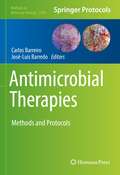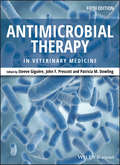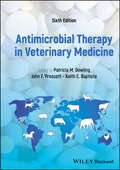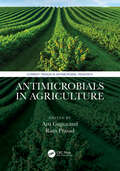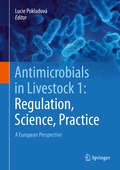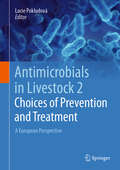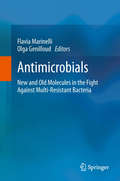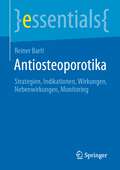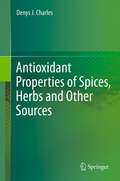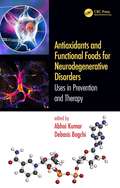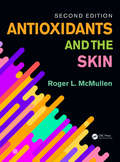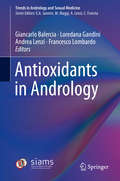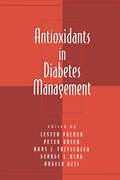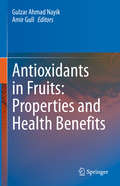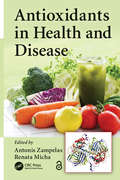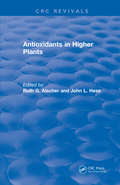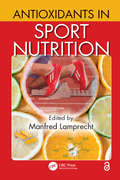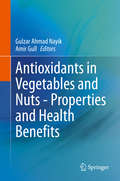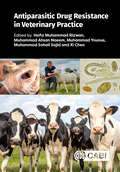- Table View
- List View
Antimicrobial Stewardship: Principles and Practice
by Eleftherios Mylonakis Kerry L. Laplante Cheston B. Cunha Haley J. Morrill Louis B. RiceIn an age where antimicrobial resistance amongst pathogens grows more prevalent, particularly in the hospital setting, antimicrobial stewardship is an evidence-based, proven measure in the battle against resistance and infection. This single comprehensive, definitive reference work is written by an international team of acknowledged experts in the field. The authors explore the effective use of coordinated antimicrobial interventions to change prescribing practice and help slow the emergence of antimicrobial resistance, ensuring that antimicrobials remain an effective treatment for infection. Amongst the first of its kind, this book provides infectious disease physicians, administrators, laboratory, pharmacy, nursing and medical staff with practical guidance in setting up antimicrobial stewardship programs in their institutions with the aim of selecting the optimal antimicrobial drug regimen, dose, duration of therapy, and route of administration.
Antimicrobial Susceptibility Testing Protocols
by Richard Schwalbe Lynn Steele-Moore Avery C. GoodwinThe clinical microbiology laboratory is often a sentinel for the detection of drug resistant strains of microorganisms. Standardized protocols require continual scrutiny to detect emerging phenotypic resistance patterns. The timely notification of clinicians with susceptibility results can initiate the alteration of antimicrobial chemotherapy and
Antimicrobial Therapies: Methods and Protocols (Methods in Molecular Biology #2296)
by José-Luis Barredo Carlos BarreiroAntimicrobial resistance will become a global health threat since antimicrobial treatments continue at the forefront of the defense against microbial infections. To respond to the issue, this detailed book explores vital methodologies currently in use to advance our understanding of antibiotic issues and answer the worldwide demand for novel antibiotics therapies. Beginning with a review chapter that guides the reader through the worldwide demand for novel antibiotics therapies, the volume continues with sections covering new screening procedures and environmental sources, advances in analytical, microbiological, and biotechnological methodologies, antibiotic production and antibiotic resistances, as well as considerations of drug trials and clinical concerns regarding multi-resistant patients. Written for the highly successful Methods in Molecular Biology series, chapters include introductions to their respective topics, lists of the necessary materials and reagents, step-by-step, readily reproducible laboratory protocols, and tips on troubleshooting and avoiding known pitfalls. Authoritative and practical, Antimicrobial Therapies: Methods and Protocols provides a reference source for health, laboratory, and industrial professionals, as well as for graduate students in a number of bio-sanitary disciplines, including medicine, nursery, biotechnology, veterinary, microbiology, genetics, molecular biology, nutrition, farming, and more.
Antimicrobial Therapy in Veterinary Medicine
by John F. Prescott Steeve Giguère Patricia M. DowlingThe Fifth Edition of Antimicrobial Therapy in Veterinary Medicine, the most comprehensive reference available on veterinary antimicrobial drug use, has been thoroughly revised and updated to reflect the rapid advancements in the field of antimicrobial therapy. Encompassing all aspects of antimicrobial drug use in animals, the book provides detailed coverage of virtually all types of antimicrobials relevant to animal health. Now with a new chapter on antimicrobial therapy in zoo animals, Antimicrobial Therapy in Veterinary Medicine offers a wealth of invaluable information for appropriately prescribing antimicrobial therapies and shaping public policy.Divided into four sections covering general principles of antimicrobial therapy, classes of antimicrobial agents, special considerations, and antimicrobial drug use in multiple animal species, the text is enhanced by tables, diagrams, and photos. Antimicrobial Therapy in Veterinary Medicine is an essential resource for anyone concerned with the appropriate use of antimicrobial drugs, including veterinary practitioners, students, public health veterinarians, and industry and research scientists.
Antimicrobial Therapy in Veterinary Medicine
by John F. Prescott Patricia M. Dowling Keith E. BaptisteProvides a comprehensive, fully updated reference book to the general principles and clinical applications of antimicrobials in veterinary medicine The sixth edition of Antimicrobial Therapy in Veterinary Medicine has been updated to reflect advances in the field, including new international contributors and a broader global outlook. It includes extensive knowledge of both general principles of mechanisms of antimicrobial drug action including specific classes of antimicrobial agents, as well as chapters dedicated to antimicrobial drug use in a wide range of animal species. As antimicrobial resistance increases as a major global issue in both human and animal health, this book’s renewed focus on antimicrobial stewardship in companion animals, in food animals, and on global aspects keeps it at the forefront of this vital field. The Sixth Edition of this classic text offers: Updates to every chapter, reflecting new developments and research, with a complete examination of the issues associated with antimicrobial resistance A comprehensive reference for all aspects of antimicrobial use in veterinary medicine, encompassing theory and practice A global perspective on antimicrobial therapy, with more international content than previous editions A stronger emphasis on antimicrobial stewardship, with practical guidance for prescribing antimicrobial drugs A companion website with tables and figures from the book available for download Antimicrobial Therapy in Veterinary Medicine is an essential and accessible resource for veterinarians, veterinary students, scientists, and professionals in veterinary medicine and antimicrobial research and stewardship.
Antimicrobial and Antiviral Materials: Polymers, Metals, Ceramics, and Applications
by Suchart Siengchin Sanjay Mavinkere Rangappa Peerawatt Nunthavarawong Mathew Thoppil-MathewEmerging microbial and viral infections are a serious challenge to health, safety, and economics around the world. Antimicrobial and antiviral technologies are needed to disrupt the progression and replication of bacteria and viruses and to counter their rapidly evolving resistance. This book discusses recent developments in materials science and engineering in combating infectious diseases and explores advances in antimicrobial and antiviral materials, including polymers, metals, and ceramics and their applications in the fight against pathogens. Features • Covers progress in biomimetic antimicrobial and antiviral materials and antimicrobial/antiviral bulk materials and coatings • Describes modern methods for disinfection of biomedical materials against microbial and viral infection resistance, especially for depressing novel coronavirus (COVID-19) • Details methods to improve material properties to have a longer service life in combating infection • Emphasizes chemical, physical, mechanical, tribological, and antimicrobial/antiviral properties • Offers current and future applications of emerging antimicrobial/antiviral technologies This book will be of interest to materials researchers and industry professionals focusing on antimicrobial and antiviral applications.
Antimicrobials in Agriculture (Current Trends in Antimicrobial Research)
by Ram Prasad Arti GuptaThis book offers comprehensive coverage of all manifestations of resistance in combating infectious diseases and explores advances in antimicrobials in agriculture and their applications in the fight against microbes. According to the World Health Organization, antimicrobial resistance is a major threat to global health because the number of alternative antibiotics is very limited. Antimicrobial resistance is a slow, evolutionary process that has been accelerated by human activities in the health, environment, and agriculture sectors. Due to their wide application, antibiotics and their residues have been found in almost all food products and natural ecosystems. This book appraises the drivers, impact, and mitigation of antimicrobials, with a focus on methods and targets. In addition, it also provides a variety of photographs, diagrams, and tables to help illustrate the material. The novel strategies to combat antimicrobial resistance are also described, emphasizing collaborative measures of control. The underlying molecular mechanisms, which depend not only on the microbe but on the specific drug molecule, are highly diverse and are covered in detail.Students, researchers, scientists, practitioners, academicians, biologists, microbiologists, stakeholders, and policymakers can benefit from current trends in antimicrobials in agriculture that address microbiology, microbial biotechnology, ethnopharmacology, toxicology, natural medicinal plant products, secondary metabolites, and all disciplines related to antimicrobial research.Features of the book: Covers antimicrobials in agriculture with up-to-date research Recent references on plausible antimicrobials in agriculture Public health impact of the use of antibiotics in agriculture Antimicrobial efficacy of medicinal plants Role of phytoalexins in agriculture Nanoparticles as antimicrobial agents Presents cutting-edge research on microbiology, nanotechnology, and emergent antimicrobial technologies
Antimicrobials in Livestock 1: A European Perspective
by Lucie PokludováThis first volume in a two-volume work enhances readers’ understanding of antimicrobial resistance mechanisms in selected bacterial species that cause diseases in major food producing animals. It provides an overview of the current legislation and policies seeking to regulate the authorisation, manufacturing, distribution and use of veterinary antimicrobials in practice in a way that helps to contain the spread of antimicrobial resistance. The focus is put on Europe, without neglecting the global context. Moreover, attention is paid to various uses of antimicrobials in livestock, considering both their risks and benefits, from the distant past to the present. Growth promotion, prophylaxis, metaphylaxis, diagnostics and treatment are discussed not only with regard to food production and animal health, but also considering the One Health concept, which combines public and animal health with environmental aspects. A summary of various systems for monitoring the use of antimicrobials is provided, as well as an overview of the diseases that European veterinarians most often treat with antimicrobials. In closing, the book addresses the complexity of recent measures that are of key importance for antimicrobial stewardship, e.g. biosecurity, vaccination and other preventive tools including the newest technologies like smart farming. The complete two-volume work provides an extensive review of various aspects related to the use of antimicrobials in veterinary medicine, especially considering major food producing species, their most common infectious diseases and causative pathogens, and mainly focusing on the situation in Europe, without ignoring the global context. While Volume I discusses more general aspects of antibiotic use such as regulatory, laboratory and practical issues from different perspectives, Volume II more specifically discusses medical aspects and the use of antimicrobials in cattle, pigs, poultry and horses, as well as pharmacokinetics and pharmacodynamics, two of the most important factors determining the success of treatment. In both volumes, each chapter confronts the reader with open questions to stimulate further discussions and future research on the topics covered.
Antimicrobials in Livestock 2: A European Perspective
by Lucie PokludováThis second volume of the two-volumes work “Antimicrobials in Livestock” offers an in-depth look at the antimicrobials commonly used in veterinary medical care of the major food producing animals pigs, poultry and cattle as well as horses, bringing to readers’ attention also pharmacokinetic and pharmacodynamic characteristics of these drugs. The individual chapters also provide a brief description of preventive tools as well as alternatives to conventional treatment options that could help minimise the use of antibiotics and combat the problems caused by increasing antimicrobial resistance. The focus is on Europe, without neglecting the global context. The complete two-volumes provide an extensive review of various aspects related to the use of antimicrobials in veterinary medicine. Volume I explores the use of antimicrobials in animals from the regulatory, practical as well scientific perspective and is targeted on EU policies and regulatory surroundings, providing also information on risks linked to the extensive use of antibiotics in livestock and highlighting importance of methods of laboratory testing for susceptibility and resistance, starting from phenotype tests and moving towards genetic analysis results providing molecular biology aspects. Each chapter confronts the reader with open questions to stimulate further discussions and future research on the topics covered. Volume II more specifically discusses medical aspects necessary for targeted, responsible, and evidence-based use of antimicrobials in cattle, pigs, poultry, and horses, as well as pharmacokinetics and pharmacodynamics as two of the most important factors necessary for proper dosing schedule setting of effective treatment. While the preface of the first volume started with questions, Volume II’s preface ends with them, having the intention to provoke more in depth and innovative thinking and might be the start of a new era, which is needed to keep antimicrobials working and available for the future generations both in human and veterinary medicine.
Antimicrobials: New and Old Molecules in the Fight Against Multi-resistant Bacteria
by Flavia Marinelli and Olga GenilloudReports on the emergence and prevalence of resistant bacterial infections in hospitals and communities raise concerns that we may soon no longer be able to rely on antibiotics as a way to control infectious diseases. Effective medical care would require the constant introduction of novel antibiotics to keep up in the “arms race” with resistant pathogens.This book closely examines the latest developments in the field of antibacterial research and development. It starts with an overview of the growing prevalence of resistant Gram-positive and Gram-negative pathogens, including their various resistance mechanisms, prevalence, risk factors and therapeutic options. The focus then shifts to a comprehensive description of all major chemical classes with antibacterial properties, their chemistry, mode of action, and the generation of analogs; information that provides the basis for the design of improved molecules to defeat microbial infections and combat the emerging resistances. In closing, recently developed compounds already in clinical use, those in preclinical or first clinical studies, and a number of promising targets to be exploited in the discovery stage are discussed.
Antiosteoporotika: Strategien, Indikationen, Wirkungen, Nebenwirkungen, Monitoring (essentials)
by Reiner BartlOsteoporose ist keine einfach hinzunehmende „Alterserscheinung“, sondern ein weltweites und zunehmendes Gesundheitsproblem. Die WHO hat die Osteoporose als eine der zehn wichtigsten und teuersten Volkskrankheiten eingestuft. In Europa sind jede dritte Frau und jeder fünfte Mann davon betroffen, mit den Folgen langanhaltender Schmerzen, körperlicher Beeinträchtigung bis hin zur Immobilität, sozialer Isolierung und Pflegebedürftigkeit. Heute ist aber der Knochenschwund in Form der Osteoporose als eine frühdiagnostizierbare, gut behandelbare und im Frühstadium sogar „heilbare“ Krankheit einzustufen. Der praktische und konsequente Einsatz der zahlreichen und unterschiedlich wirksamen Medikamente ist jetzt Aufgabe der behandelnden Ärzte und betroffenen Patienten– eine multidisziplinäre Anstrengung, die sich lohnt!…Osteoporose ist heute so überflüssig wie ein Kropf!
Antioxidant Nutraceuticals: Preventive and Healthcare Applications (Nutraceuticals)
by Chuanhai Cao Sarvadaman Pathak Kiran PatilThis book addresses various clinical and sub clinical applications of antioxidant nutraceuticals, with a primary focus on preventive use for general wellness, common ailments, and such chronic illnesses as cancer and neurological applications. This unique book captures the applications of natural antioxidants, which have been used for thousands of years in Traditional Chinese Medicine and Ayurvedic Medicine as well as modern nutraceuticals formulations. It covers antioxidant applications in clinical scenarios including the historical perspective, basic antioxidant properties and applications, anti-inflammatory properties, and antioxidant applications in a variety of clinical conditions.
Antioxidant Properties of Spices, Herbs and Other Sources
by Denys J. CharlesThe scientific world and modern society today is experiencing the dawning of an era of herbal medicine. Extensive research has shown that aromatic plants are important anti-inflammatory, antioxidant, anti aging and immune boosting delectable foods, with the magic and miracle to boost our immune system providing us with extended and an improved quality of life. Apart from making bland recipes into welcoming or interesting victories, herbs and spices have stirred the minds of the research community to look deeper into its active components from a functional perspective. It is essential to present the scientific and medicinal aspect of herbs and spices together with the analysis of constituents, its medicinal application, toxicology and its physiological effects. Herbs and spices with high levels of antioxidants are in great demand as they tend to promote health and prevent diseases naturally assuring increased safety and reliability for consumers. Herbs and spices are not only known for taste and flavor, but today research has opened up a new realm in which the antioxidant properties of these aromatic plants provide preservation for foods and health benefits for consumers who look forward to concrete scientific research to guide them further and explore herbal medicine. The aim of this book is to create awareness in society about the reliability of medicinal properties of certain herbs and spices through scientific and scholarly research.
Antioxidant Status, Diet, Nutrition, and Health (Contemporary Food Science Ser. #9)
by Andreas M. PapasThis is the first book to integrate the biological, nutritional, and health aspects of antioxidant status. Fifty contributors integrate and transfer the knowledge of free radicals and antioxidants from the test tube to the laboratory of the biologist, clinical nutritionist, and medical researcher, as well as to the office of the dietician, nutritionist, and physician. Topics examined include factors affecting and methods for evaluating antioxidant status in humans; effect of diet and physiological stage (infancy, aging, exercise, alcoholism, HIV infection, etc.) on antioxidant status; and the role of antioxidant status in nutrition, health, and disease.
Antioxidants and Disease Prevention (Modern Nutrition)
by Harinder GarewalThe role of antioxidants and other nutritional agents in disease prevention is a widely discussed subject, attracting attention from professionals in all areas of medicine. This often-debated and rapidly evolving area of medicine could have important implications for how diseases are treated.
Antioxidants and Functional Foods for Neurodegenerative Disorders: Uses in Prevention and Therapy
by Debasis Bagchi Abhai KumarNeurodegenerative diseases, including Alzheimer’s and Parkinson’s disease, are a growing problem across the world’s aging population. Oxidative stress in the brain plays a central role in a common pathophysiology of these diseases. This book presents scientific research on the potential of antioxidant therapy in the prevention and treatment of neurodegenerative disorders.This book outlines the roles of oxidative stress and diabetes mellitus in neurodegeneration, describes the molecular mechanisms of neurodegenerative disorders including the roles of environmental pollutants and inflammatory responses, and explores mitochondrial dysfunction. It then describes the protective abilities of antioxidants – including vitamin D, tocotrienol and coenzyme Q10 – against neurodegeneration. The book demonstrates the therapeutic potential of ketogenic diets, and highlights the roles of medicinal plants, phytopharmaceuticals, traditional medicines and food nutrients in neuroprotection.Key Features: Explains damage caused by numerous neurodegenerative disorders and the possible protection offered by antioxidants and functional foods. Describes molecular mechanisms of neurodegeneration by oxidative stress, advancing age, diabetes and mitochondrial dysfunctions. Demonstrates protection offered by nutraceuticals, antioxidants, botanical extracts and functional foods. The book contains twenty-three chapters divided into six sections written by leading researchers. This book is essential reading for health professionals, dietitians, food and nutrition scientists and anyone wanting to improve their knowledge of etiology of neurodegenerative diseases.
Antioxidants and the Skin: Second Edition
by Roger L. McMullenThis highly illustrated book brings together many concepts related to skin care and antioxidant usage in one convenient text. The second edition now contains the latest antioxidants being marketed, and an analysis of risks and benefits associated.
Antioxidants in Andrology (Trends in Andrology and Sexual Medicine)
by Andrea Lenzi Giancarlo Balercia Loredana Gandini Francesco LombardoThis book focuses on the use of various molecules with antioxidant properties in the treatment of major male genital tract disorders, especially male infertility, erectile dysfunction, and accessory gland infection. The coverage also includes discussion of pathophysiology, the molecular basis of male infertility, and the rationale for use of antioxidants, with particular attention to coenzyme Q10 and carnitine. Oxidative stress occurs when the production of reactive oxygen species, including free radicals, exceeds the body's natural antioxidant defences, leading to cellular damage. Oxidative stress is present in about half of all infertile men, and reactive oxygen species can produce infertility both by damaging the sperm membrane, with consequences for sperm motility, and by altering the sperm DNA. There is consequently a clear rationale for the use of antioxidant treatments within andrology, and various in vitro and in vivo studies have indicated that many antioxidants indeed have beneficial impacts. In providing a detailed and up-to-date overview of the subject, this book will be of interest to both practitioners and researchers in andrology, endocrinology, and urology.
Antioxidants in Diabetes Management (Oxidative Stress and Disease)
by Lester Packer Peter Roser Hans J. Tritschler George L. King Anglo A221This volume summarizes current understanding of the pathogenic role of oxidative stress in the onset and progression of diabetes and its complications, and presents results of studies aimed at regulating oxidatively induced complications through the use of antioxidants. Examines the presence of impaired microcirculation, capillary hypoxia, and
Antioxidants in Fruits: Properties and Health Benefits
by Gulzar Ahmad Nayik Amir GullThis book provides a comprehensive review of the antioxidant value of widely consumed fruits. Each chapter covers the botanical description, nutritional & health properties of these popular fruits. Fruits are one of the most important indicators of dietary quality and offer protective effects against several chronic diseases such as cardiovascular diseases, obesity, and various types of cancer. In order to effectively promote fruit consumption, it is necessary to know and understand the components of fruits. In addition to underscoring the importance of fruit consumption’s effects on human diet, the book addresses the characterization of the chemical compounds that are responsible for the antioxidant proprieties of various fruits.Given its scope, the book will be of interest to graduate and post-graduate students, research scholars, academics, pomologists and agricultural scientists alike. Those working in various fruit processing industries and other horticultural departments will also find the comprehensive information relevant to their work.
Antioxidants in Health and Disease
by Antonis Zampelas and Renata MichaAntioxidant use in health promotion and disease prevention either through dietary intake or supplementation is controversial. This book reviews the latest evidence-based research in the area, principally through prospective cohort studies and randomized controlled trials. It assesses major dietary antioxidants and discusses their use in diseases such as cancer, diabetes, stroke, coronary heart disease, HIV/AIDS, and neurodegenerative and immune diseases. The use of antioxidants in health is also discussed along with common adverse effects associated with antioxidant use.
Antioxidants in Higher Plants (CRC Press Revivals)
by Ruth G. Alscher John L. HessAntioxidants in Higher Plants provides a unique blend of molecular and biochemical approaches to cover the state of the art in antioxidant function. The chemistry and protective potential of sulfhydryl and hydroxyl compounds are emphasized. Interesting perspectives are presented regarding the response of antioxidant metabolism to interactions among environmental pollutants, illumination, temperature, and water availability. The book also discusses how tools of molecular biology may further clarify antioxidant function and response to stress. Antioxidants in Higher Plants will be an excellent reference for plant physiologists, biochemists, molecular biologists, ecologists, and students.
Antioxidants in Sport Nutrition
by Manfred LamprechtAntioxidant use in sports is controversial due to existing evidence that it both supports and hurts athletic performance. This book presents information on antioxidants, specifically for athletes, and their roles in sports nutrition. It stresses how antioxidants affect exercise performance, health, and immunity. Chapters cover oxidative stress; basic nutrition for athletes; major dietary antioxidants; sports supplements; performance/adaptation to exercise; antioxidants role in health and immunity; reviews on vitamins C, E, beta-carotene, and minerals in sports nutrition; and roles polyphenols play in high-performance sport.
Antioxidants in Vegetables and Nuts - Properties and Health Benefits
by Gulzar Ahmad Nayik Amir GullThis book covers the nutritional and nutraceutical profiles of a wide range of popularly consumed vegetables and nuts. The first half of the book focuses on popular vegetables, and describes how higher vegetable consumption reduces the risk of diseases ranging from diabetes to osteoporosis, diseases of the gastrointestinal tract, cardiovascular diseases, autoimmune diseases and cancer. The book also includes an interesting section on the antioxidant potential of mushrooms. In turn, the second half discusses the nutritional value of various nuts. Nuts are nutrient-dense foods with complex matrices rich in unsaturated fats, high-quality protein, fiber, minerals, tocopherols, phytosterols and phenolics. The respective chapters illustrate how the consumption of nuts could ward off chronic diseases like hypertension, cancer, inflammation, oxidative stress, high blood pressure, coronary heart disease etc. In order to effectively promote vegetable and nut consumption, it is necessary to know and understand the nutritional and nutraceutical profiles of vegetables & nuts. Given its scope, the book will be of interest to students, researchers, food scientists, olericulturists, dietitians and agricultural scientists alike. Those working in the vegetable and nut processing industries, horticultural departments and other agricultural departments will also find the comprehensive information relevant to their work.
Antiparasitic Drug Resistance in Veterinary Practice
by Muhammad Usman Muhammad Imran Haider Abbas Dr Hafiz Muhammad Rizwan Dr Muhammad Sohail Sajid Dr Waqas Ahmad Muhammad Qasim Tooba Abbas Sumra Wajid Abbasi Zobia Afsheen Adeel Ahmad Zubaria Shahid Amin Farid Shokry Ataya Faiza Bano Ian Daniel Shamshad Fareed Zahid Fareed Muhammad Umar Farid Dalia Fouad Sadia Ghazanfar Adil Ijaz Ibadullah Jan Malcolm K. Jones Kashif Kamran Muhammad Abdullah Malik Zahid Manzoor Mahvish Maqbool Aiman Maqsood Manuela Marescotti Amir Munir Hizqeel Ahmed Muzaffar Shumaila Naz Nadia Nazish Fakhar Un Nisa HazratUllah Raheemi Haroon Rashid Muhammad Muneeb Rauf Mohsin Raza Aayesha Riaz Evelyn Saba Sadaf Faiz Abdullah Arif Saeed Muhammad Rizwan Saeed Rida Fatima Saeed Muhammad Nadeem Saleem Urfa Bin Tahir Rohit Tyagi Professor Muhammad Younus Muhammad Zeeshan Mian Mubashar Saleem M. Rajput Qaiser Akram Sibtain AhmadLack of clean water, inadequate sanitation, and insufficient infection prevention and control promote the spread of parasites. The discovery of antiparasitic drugs was considered a milestone in the veterinary and medical sciences, but their use has subsequently become limited due to the emergence of resistance. While plenty of attention has been given in human and animal health communities to the global threat of antimicrobial drug resistance, specific antiparasitic advice is less available. This book provides an in-depth view of the issue for parasitologists, pharmacologists and veterinary scientists. Specifically discussing antiparasitic drug resistance mechanisms and factors responsible for the problem, it covers: The physiological basis of parasitism; Resistance across protozoa, helminths, insects, mites and ticks; Molecular and phenotypic diagnostic methods; Practical strategies for mitigating resistance development. While it is clear that the veterinary field urgently requires the development of new antiparasitic drugs, of equal or even increased importance is the evaluation of alternative therapies and formulation of stringent policies to ensure appropriate drug use in veterinary practice. Highlighting the importance and development of resistance across different parasite groups, this book covers factors responsible for resistance development and advises strategies for effective stewardship and resistance mitigation.
